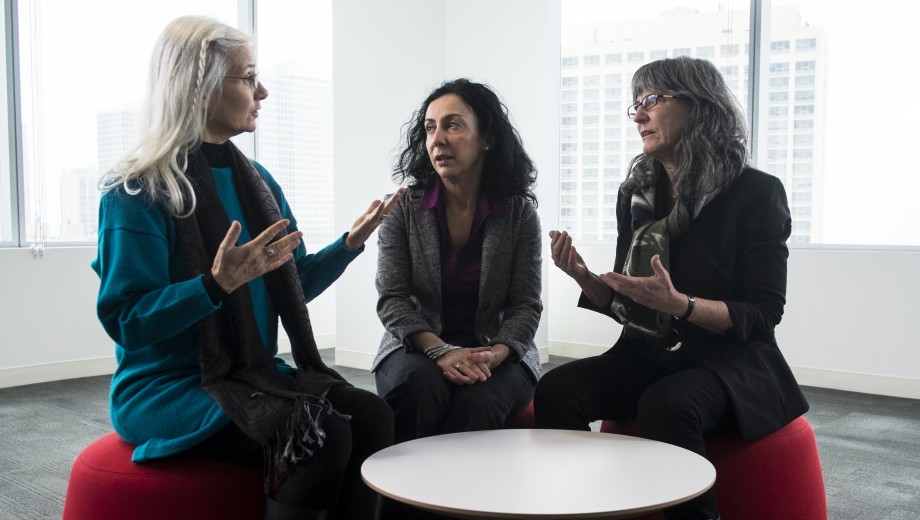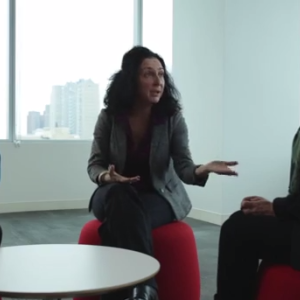When sign language linguistics expert Diane Brentari, PhD’90, joined the University faculty in 2011, she found herself among a growing group of linguists and psychologists interested in both established and emergent sign languages. Brentari partnered with UChicago semanticist Anastasia Giannakidou, who studies meaning in language, and psychologist Susan Goldin-Meadow, an expert on both gesture and home sign—improvised sign systems developed by deaf children of hearing parents.
In 2013 the three formed the Center for Gesture, Sign, and Language to investigate sign language, language emergence, and the relationship between body and mind. With major funding from the Neubauer Collegium for Culture and Society, they have launched an ambitious three year-project: The Body's Role in Thinking, Performing, and Referencing. The project extends the trio’s collaboration beyond Linguistics and Psychology to involve scholars from many disciplines including the performing arts. They spoke with Tableau about the questions that guide their work.
What do we know about the difference between gesture and sign?
Susan Goldin-Meadow: Sign is a language. Gesture is not a language, but it works along with language to convey our ideas. Gesture is part of the communicative act, and it’s important to psychologists who use it as a window into the mind.
Diane Brentari: When we talk about gesture, we're really talking about the contrast between what's codified in the linguistic system—sign language or speech—and this “window into the mind” as we use our hands and bodies to convey meanings over which we don’t have as much control.
SGM: We do know that signers gesture. The hard part, though, is, because it's all coming out of the
hand—
Anastasia Giannakidou: —it's hard to distinguish.
SGM: The studies that we've planned are trying to figure out where sign stops and where gesture begins.
With Sian Beilock, a cognitive psychologist, you’re studying golfers. Why?
SGM: We're going to bring in golfers, ask them to swing, and then ask them to talk about their golf swing. When you talk about your golf swing, you will inevitably gesture. So we'll have gesturing—representational action—compared to real action.
We can begin to distinguish what gesture looks like, how much it gets its information from real action, and how much it differs from action. We’ll then move to deaf signers, who we believe will also gesture when they talk about their golf swing. We will explore where their sign stops and their gesture begins.
Our plan is to use data from hearing golfers to figure out the boundary between gesture and sign in deaf golfers. Although it seems narrow, in fact our golf study will explore the entire continuum from action to gesture to sign language.
DB: We'll be using motion-capture equipment to get very precise measurements of each of these different manual expressive categories. We can't perceive many of the subtle movement dynamics with the naked eye. The kind of information we get from motion capture will tell us a little bit about the prosodic structure—the melody—of gesture and sign language.
What is home sign and why is it important to study?
SGM: Diane and I have been doing research in Nicaragua looking at deaf people who interact only with hearing people and no other deaf people. Each deaf individual develops a sign language at home, called home sign. At one point many home signers came together to form the first stage of Nicaraguan sign language, and that first stage formed the basis for subsequent stages. Looking at each stage, our goal is to figure out when pieces of the system become syntactic.
AG: Often as linguists we receive the question, “How was language created?” Usually we cannot answer because we don't have the evidence. But with sign languages, we actually have the evidence of how, in stages, they become languages. We need to develop a theory to trace the trajectory from the gestural system to the home sign system and then the sign language system.
DB: Working with signers gives us the chance to study the emergence of language and of controlled, psycholinguistic tasks that we can’t use for spoken languages. New sign languages are continuing to be discovered.
SGM: They’re all over the world.
DB: When isolated individuals come together and use their hands as their primary communication, that’s where you see language spontaneously combust.
How did you become interested in gesture and sign language?
DB: I grew up with a deaf cousin, and I was always fascinated by her worldview. I could tell that it was different from mine, even though we lived in the same town. As a child I wanted to understand how being deaf and using sign language might create a culture of its own.
SGM: I wanted to understand how children learn language, whether they need linguistic input and what kind. I was an undergraduate at Smith College, down the street from Clarke School for Hearing and Speech. It's an oral school, which means that the students were not exposed to sign language at all. Everybody said that at the Clarke School, the kids tried to talk during the lessons, but out in the playground and elsewhere, they signed to each other all the time. That's what I wanted to study: the sign languages created by deaf children in hearing worlds.
AG: Susan approached me a few years back with some exciting data about negation in the home sign she was studying. Negation is expressed in English with little words like “no” or “not” that don’t seem to refer to objects in the world the way words like “table” and “chair” do. It turns out that home sign and sign languages seem to represent those kinds of meanings in ways consistent with both the logic and the syntax of negation in natural language.
As a semanticist, I was interested in reflecting on these parallels as well as potential differences between home sign and spoken language. The driving question in my work with Susan is, What are the essential building blocks that we can use as evidence to characterize a system of signs as being language-like or linguistic?


